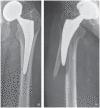Postoperative periprosthetic femoral fracture around total hip replacements: current concepts and clinical outcomes
- PMID: 33072408
- PMCID: PMC7528669
- DOI: 10.1302/2058-5241.5.200003
Postoperative periprosthetic femoral fracture around total hip replacements: current concepts and clinical outcomes
Abstract
The rising incidence of postoperative periprosthetic femoral fracture (PFF) presents a significant clinical and economic burden.A detailed understanding of risk factors is required in order to guide preventative strategies.Different femoral stems have unique characteristics and management strategies must be tailored appropriately.Consensus regarding treatment of PFFs around well-fixed stems is lacking, but revision surgery may provide more predictable outcomes for unstable fracture patterns and fractures around polished taper-slip stems.Future research should focus on implant-related risk factors, treatment of concurrent metabolic bone disease and the use of large endoprostheses. Cite this article: EFORT Open Rev 2020;5:558-567. DOI: 10.1302/2058-5241.5.200003.
Keywords: current concepts; periprosthetic fracture; risk factors; surgical treatment; total hip replacement.
© 2020 The author(s).
Figures



References
-
- Learmonth ID, Young C, Rorabeck C. The operation of the century: total hip replacement. Lancet 2007;370:1508–1519. - PubMed
-
- OECD. Hip and knee replacement. In Health at a glance 2017: OECD indicators. Paris: OECD Publishing.
-
- Abdel MP, Watts CD, Houdek MT, Lewallen DG, Berry DJ. Epidemiology of periprosthetic fracture of the femur in 32 644 primary total hip arthroplasties: a 40-year experience. Bone Joint J 2016;98-B:461–467. - PubMed
-
- Pivec R, Issa K, Kapadia BH, et al. Incidence and future projections of periprosthetic femoral fracture following primary total hip arthroplasty: an analysis of international registry data. J Long Term Eff Med Implants 2015;25:269–275. - PubMed
-
- National Joint Registry 16th Annual Report 2019: https://reports.njrcentre.org.uk/Portals/0/PDFdownloads/NJR%2016th%20Ann... (date last accessed 8th January 2020). - PubMed
Publication types
LinkOut - more resources
Full Text Sources

